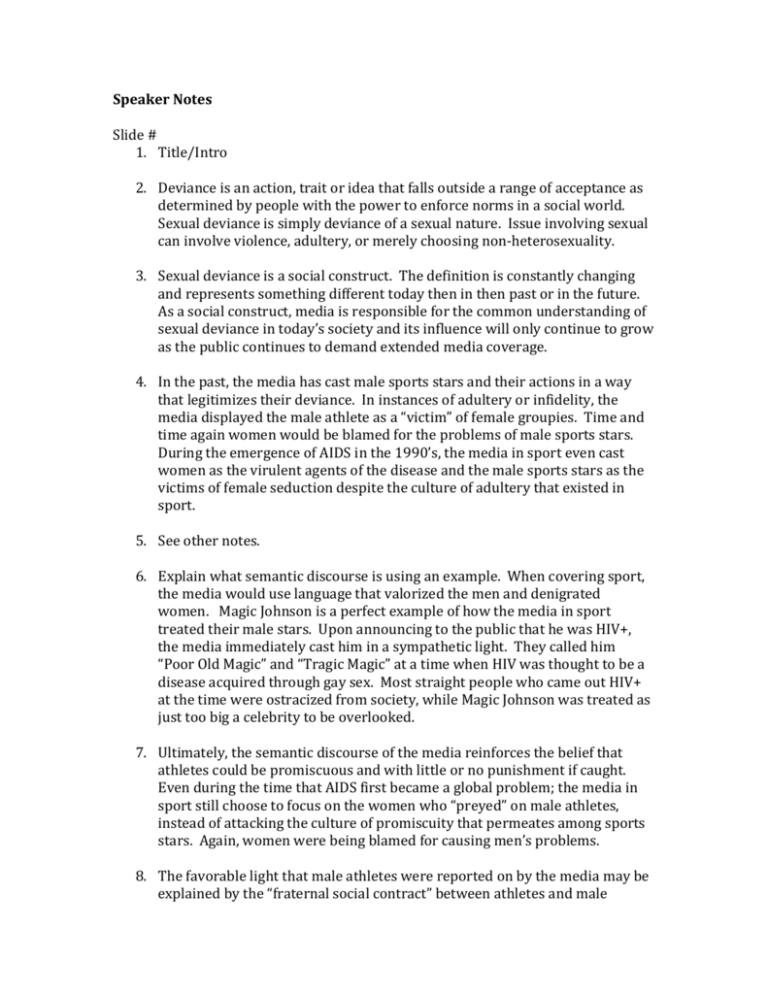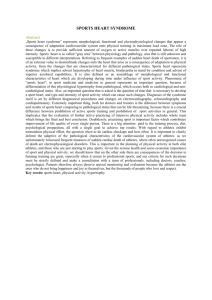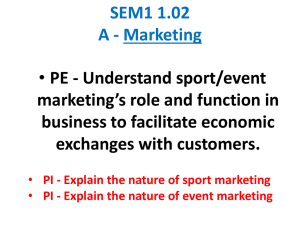
Speaker Notes
Slide #
1. Title/Intro
2. Deviance is an action, trait or idea that falls outside a range of acceptance as
determined by people with the power to enforce norms in a social world.
Sexual deviance is simply deviance of a sexual nature. Issue involving sexual
can involve violence, adultery, or merely choosing non-heterosexuality.
3. Sexual deviance is a social construct. The definition is constantly changing
and represents something different today then in then past or in the future.
As a social construct, media is responsible for the common understanding of
sexual deviance in today’s society and its influence will only continue to grow
as the public continues to demand extended media coverage.
4. In the past, the media has cast male sports stars and their actions in a way
that legitimizes their deviance. In instances of adultery or infidelity, the
media displayed the male athlete as a “victim” of female groupies. Time and
time again women would be blamed for the problems of male sports stars.
During the emergence of AIDS in the 1990’s, the media in sport even cast
women as the virulent agents of the disease and the male sports stars as the
victims of female seduction despite the culture of adultery that existed in
sport.
5. See other notes.
6. Explain what semantic discourse is using an example. When covering sport,
the media would use language that valorized the men and denigrated
women. Magic Johnson is a perfect example of how the media in sport
treated their male stars. Upon announcing to the public that he was HIV+,
the media immediately cast him in a sympathetic light. They called him
“Poor Old Magic” and “Tragic Magic” at a time when HIV was thought to be a
disease acquired through gay sex. Most straight people who came out HIV+
at the time were ostracized from society, while Magic Johnson was treated as
just too big a celebrity to be overlooked.
7. Ultimately, the semantic discourse of the media reinforces the belief that
athletes could be promiscuous and with little or no punishment if caught.
Even during the time that AIDS first became a global problem; the media in
sport still choose to focus on the women who “preyed” on male athletes,
instead of attacking the culture of promiscuity that permeates among sports
stars. Again, women were being blamed for causing men’s problems.
8. The favorable light that male athletes were reported on by the media may be
explained by the “fraternal social contract” between athletes and male
journalists. Journalists were wary of betraying athletes and their secrets as
they could lose locker room access and be shunned not only by a player, but
also their peers in sport journalism. Thus the media provided very few
criticisms about the sexual lifestyles of athletes even though they were aware
of the deviance among players. This culture surrounding locker rooms is
changing fast and the media is quickly losing sympathy for male sports stars
and their “fast food sex” mentality. This change can be partially explained by
the new type of information that fans are asking for from their media. In the
past, fans only cared about statistics, but today’s media shifts toward tabloid
journalism has created a new demand for information concerning the private
and sexual lives of professional athletes. may want to add some more here
about why the media’s values are changing*









